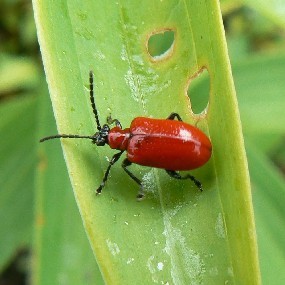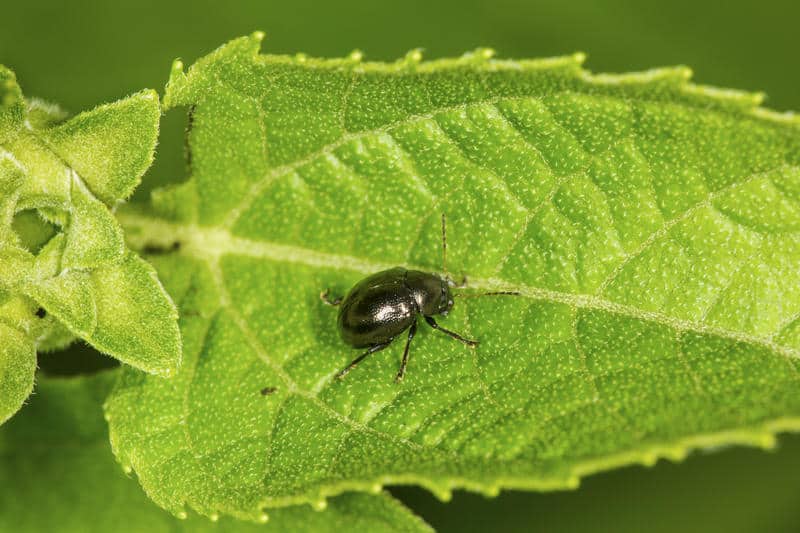Current Newsletter
Charlie’s Early May Newsletter
The Other Lilies, Brussels Sprouts and Kohlrabi, Grow Some Nasturtiums and Flea Beetles

The highlight of my day was getting my tractor back from the mechanic’s shop so I can start mowing and moving wood chips and compost. It’s these simple pleasures that make a gardener smile! It’s just in time because with cool temperatures and rain in our zone 5 Vermont garden, everything is growing fast!
The planting continues and it’s time to pop in some bulb lilies. The most popular are the Asiatic and Oriental lilies, but I like some of the species types. I call them the “other lilies” because they are less know and grown. I highlight some of my favorites in this newsletter.
Our Brassicas are in the ground and the two I really love are Brussels sprouts and kohlrabi. Brussels sprouts have become the darlings of chefs with roasted Brussels sprouts being a common menu item. Kohlrabi still doesn’t get the attention it deserves. It’s easy to grow and fast to mature. It has a crunchy, sweet taste with just a slight cabbage family flavor. I talk, about both of these Brassicas here.

We have many annual flowers that like to self sow in our garden each year. That’s fine with us. It’s less seeds and plants we have to purchase and it’s fun to move them around. I’ve noticed the nasturtiums are starting to grow. This delightful, edible flower comes in trailing and mounding varieties with flowers in colors ranging from white to deep red. It also has a talent for warding off pests. Read more in this newsletter.
Since it’s the gardening season, I’ll start highlighting certain pests that are around already. If you’ve put out your broccoli or eggplant seedlings (in warmer climates), then you known about flea beetles. These small, black beetles create shotgun-like holes in seedlings leaves. I talk about controlling them here.
Remember to check out my monthly garden blog I write for Proven Winners called What’s Up North. The May blog should be up soon and features great, plant combination ideas for containers.
Until next time I’ll be seeing you, in the garden.
Charlie

Where to Find Charlie: (podcasts, TV and in-person)
- In the Garden (WCAX-TV CBS) – This week: Repotting Tomatoes
- All Things Gardening on Vt Public Radio– This week: Weeding 101
- WJOY In The Garden Podcast– This week: Growing moss roses, cutting back begonias and geraniums, weeds, and transplanting rhododendron and more
- Where’s Charlie Speaking? 5/12/25- John Hays Estate at the Fells, Lake Sunapee, NH. Talk on No Dig Gardening
How to Grow: Unusual Lilies

Some of my favorite summer bulbs are in the lily family. This is the group of bulbs that includes the Asiatic and Oriental lilies. This does not include day lilies. The lilies I really appreciate aren’t the most common. They are what I call the “other lilies”. They tend to be tall, species lilies that are loaded with colorful flowers and lower maintenance than many of the hybrids types. We grow them in the back of our flower borders for a stunning display.
Tiger lilies (L. lancefolium) lead the charge. ‘Red’ Tiger lily features bright red flowers on zone 4 hardy bulbs that grow 3- to 4- feet tall. The flowers are showy and stand tall making them easy to appreciate. There’s an ‘Orange’ Tiger lily version as well with black speckled flower petals. Both types will spread over time to create a swath of lilies in your garden. They are fragrant, favorites of butterflies and bees and deer don’t like them.

For a truly fragrant lily, why not grow the parent of many of the fragrant Oriental types? The ‘Wild Golden Rayed Lily of Japan (L. auratum) has spread its genes into many of the most fragrant lilies we know including ‘Casa Blanca’ and ‘Stargazer’. This parent blooms a bit later than other Orientals with large, fragrant while flowers with golden streaks. It’s a 2- to 4- feet tall, hardy, butterfly attracting flower that’s a must for cutting.
Martagon’ lilies feature 2- to 4-feet tall plants with up to 50 downward facing, small flowers. It’s a classic for the back of a border. The flowers colors can be yellow, orange, pink or red. It’s naturalizes over time and unlike other lilies, grows and flowers in part shade.

Grow these species lilies as you would the hybrids. Most prefer full sun and well-drained soil is a must. Plant bulbs now or in fall. Keep the soil evenly moist, but not wet. Grow tall varieties in clumps so they can support each other or plant them near other tall perennials or shrubs. Keep the ground well weeded and mulched. Some of these species lilies will drop seeds and spread over time. Decide if you want more lilies and weed out those you don’t want. For the ones left behind, thin the plants so they aren’t overcrowded which causes them to not flower. Cut off spent flowers, but leave the stalks and leaves to feed the bulbs.
The most important pest of bulb lilies is the red lily leaf beetle. Hand crush the red adults now as the lilies emerge. Grow resistant varieties such as ‘Black Beauty’. Learn more about controlling the red lily leaf beetle here.
Learn more about lilies here
Check out my Webinar on Summer Bulbs here
How to Grow: Brussels Sprouts and Kohlrabi

There’s no BS in Brussels sprouts. This is a seriously good vegetable, often found on menus of fine restaurants. I love growing them because they are tasty and easy. Brussels sprout is a long season vegetable that doesn’t mature until September when small “balls or sprouts” appear all along the stalk. They can grow 4 feet tall so can have lots of sprouts. Some popular varieties are ‘Divino’ (it doesn’t lodge) and ‘Sylvia’ (disease resistant). ‘Red Rubine’ has purplish-red sprouts that hold their color when cooked. Grow Brussels sprouts in full sun on fertile soil but don’t add too much compost. The plants will keep growing and be very late to form sprouts. To encourage sprout formation, top the plant in fall so it sends more energy into making sprouts.

Kohlrabi is another Brassica that should be getting more attention. This cabbage family crop is fast to mature. It produces a round, tennis-ball sized, swollen stem at the soil line that’s eaten. Peel a kohlrabi and eat it raw as a crudites, roast or bake it. I love the crunchiness and mild flavor of kohlrabi. We grow the white skinned ‘Beas’ variety but there are also green and red skinned varieties as well such as ‘Kossak’ and ‘Kolibri’. They all have the same white flesh. Plant kohlrabi plants now. Like all Brassicas they like it cool. In about 40 to 50 days, you’ll see the ball form. Harvest at any stage. The smaller sized kohlrabis are more tender.
Buy transplants now or start seedlings for the fall. Kohlrabi grows best in cool weather. Protect all Brassicas from cabbage worms and Swede midge flies with a micromesh floating row cover. Since these veggies don’t need flower pollination, we grow our plants under cover all summer. This reduces the need to spray. The micromesh lets in air light and water, but blocks the egg laying insects.
Learn more about growing Brussels Sprouts here
Learn more about growing Kohlrabi here and watch the video
Nasturtiums

We love growing edible flowers. Not only do these annuals add color to the garden, they have interesting flavors. One of our favorites is nasturtiums. Nasturtiums are annual flowers in most gardens except in coastal California where they overwinter and can become a weed! There are two different types. The trailing types, such as ‘Moonlight’, sprawl around the garden and are best trained up a trellis or fence. The mounding types, such as ‘Alaska’, stay in small mounds and are best in the front of a flower border or mixed in a container.

Nasturtiums are colorful. The varieties range in colors from orange to salmon to white. They thrive in full sun on well-drained, fertile soil. Soak seeds overnight to hasten germination. Don’t add too much compost when planting, though, or they will be slow to flower. The flowers and leaves are edible having a peppery flavor. We love them in salads, soups and as garnishes on cooked dishes.
One of the lesser known claims to fame of nasturtiums is their ability to ward off pests. They are a great companion plant for squashes. When grown as a companion plant with squash, their fragrance confuses the squash bug adults so they can’t find the squashes to lay their eggs. You have to grow the nasturtiums a few weeks before planting the squash so they can get established, and grow the trailing types.
Go here for more on growing Nasturtiums
In Our Garden: Pest of the Month: Flea Beetles

If your seedlings of eggplants, broccoli and kale are loaded with small, shotgun-like holes, look closer. You’ll probably find the flea beetle. This black adult insect looks like a beetle, but hops like a flea when disturbed. They come out early in the season and love to eat holes in many seedling leaves. If severe enough, they could kill the seedling. But even lesser damage can stunt the plant. Once the plants are large, flea beetles aren’t a problem.

To control flea beetles think in turns of a few weeks. We will cover our seedlings with row covers for 2 to 3 weeks until flea beetle season is over. But they will overwinter in the soil, so you have to check and make sure you didn’t just lock them inside with your seedlings. You can also dust seedlings with kaolin clay or diatomaceous earth. However, these organic sprays are less effective after a rain.
One newer idea is to companion plant to reduce the flea beetles. Flea beetles love bok choi and radishes. They also don’t travel far, so you can plant a row of these trap crops next to your seedlings. You’ll see the flea beetles attack and stay in the radishes and bok choi, not bothering the other plants. If they do start to migrate, simply remove the trap crop to remove the beetles as well.



